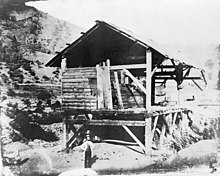
John Augustus Sutter, born Johann August Sutter and known in Spanish as Don Juan Sutter, was a Swiss immigrant who became a Mexican and later an American citizen, known for establishing Sutter's Fort in the area that would eventually become Sacramento, California, the state's capital. Although he became famous following the discovery of gold by his employee James W. Marshall and the mill-making team at Sutter's Mill, Sutter saw his own business ventures fail during the California Gold Rush. Those of his elder son, John Augustus Sutter Jr., were more successful.

Sacramento is the capital city of the U.S. state of California and the county seat of Sacramento County. Located at the confluence of the Sacramento and American Rivers in Northern California's Sacramento Valley, Sacramento's 2020 population of 524,943 makes it the fourth-most populous city in Northern California, sixth-most populous city in the state, and the ninth-most populous state capital in the United States. Sacramento is the seat of the California Legislature and the Governor of California.

Sutter's Fort was a 19th-century agricultural and trade colony in the Mexican Alta California province. Established in 1839, the site of the fort was originally called New Helvetia by its builder John Sutter, though construction of the fort proper would not begin until 1841. The fort was the first non-indigenous community in the California Central Valley. The fort is famous for its association with the Donner Party, the California Gold Rush, and the formation of the city of Sacramento, surrounding the fort. It is notable for its proximity to the end of the California Trail and Siskiyou Trails, which it served as a waystation.

The California gold rush (1848–1855) was a gold rush that began on January 24, 1848, when gold was found by James W. Marshall at Sutter's Mill in Coloma, California. The news of gold brought approximately 300,000 people to California from the rest of the United States and abroad. The sudden influx of gold into the money supply reinvigorated the American economy; the sudden population increase allowed California to go rapidly to statehood in the Compromise of 1850. The Gold Rush had severe effects on Native Californians and accelerated the Native American population's decline from disease, starvation, and the California genocide.
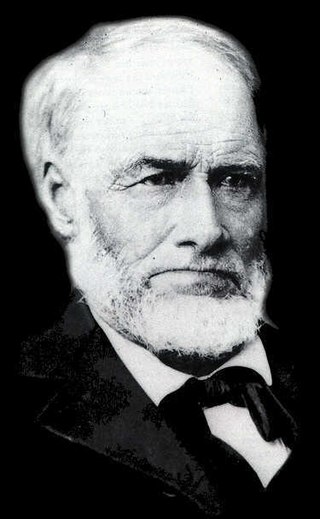
James Wilson Marshall was an American carpenter and sawmill operator, who on January 24, 1848, reported the finding of gold at Coloma, California, a small settlement on the American River about 36 miles northeast of Sacramento. His discovery was the impetus for the California Gold Rush. The mill property was owned by Johann (John) Sutter who employed Marshall to build his mill. The wave of gold seekers turned everyone's attention away from the mill which eventually fell into disrepair and was never used as intended. Neither Marshall nor Sutter ever profited from the gold find.
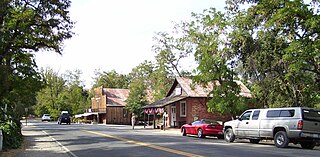
Coloma is a census-designated place in El Dorado County, California, US. It is approximately 36 miles (58 km) northeast of Sacramento, California. Coloma is most noted for being the site where James W. Marshall found gold in the Sierra Nevada foothills, at Sutter's Mill on January 24, 1848, leading to the California Gold Rush. Coloma's population is 529.

State Route 49 is a north–south state highway in the U.S. state of California that passes through many historic mining communities of the 1849 California gold rush and it is known as the Golden Chain Highway. The highway's creation was lobbied by the Mother Lode Highway Association, a group of locals and historians seeking a single highway to connect many relevant locations along the Gold Rush to honor the 49ers. One of the bridges along SR 49 is named for the leader of the association, Archie Stevenot.

Carbonaceous chondrites or C chondrites are a class of chondritic meteorites comprising at least 8 known groups and many ungrouped meteorites. They include some of the most primitive known meteorites. The C chondrites represent only a small proportion (4.6%) of meteorite falls.

Marshall Gold Discovery State Historic Park is a state park of California, United States, marking the discovery of gold by James W. Marshall at Sutter's Mill in 1848, sparking the California Gold Rush. The park grounds include much of the historic town of Coloma, California, which is now considered a ghost town as well as a National Historic Landmark District. The park contains thre California Historical Landmarks: a monument to commemorate James Marshall (#143), the actual spot where he first discovered gold in 1848 (#530). Established in 1942, and Coloma Road (#748),. The park now comprises 576 acres (233 ha) in El Dorado County.
The history of Sacramento, California, began with its founding by Samuel Brannan and John Augustus Sutter, Jr. in 1848 around an embarcadero that his father, John Sutter, Sr. constructed at the confluence of the American and Sacramento Rivers a few years prior.

Mormon Island was once a mining town, which had an abundance of Mormon immigrants seeking gold in the American River during the California Gold Rush. Its site is in present-day Sacramento County, California.
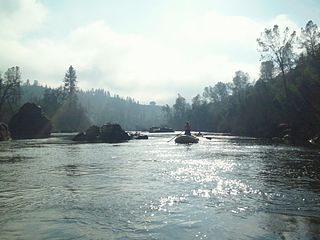
The South Fork American River is a major tributary of the American River in El Dorado County, California, draining a watershed on the western slope of the Sierra Nevada east of Sacramento. The river begins in pristine Desolation Wilderness and flows through the Sierra Nevada foothills. The river at Coloma was the site of James Marshall's discovery of gold at Sutter's Mill on January 24, 1848, which started the California Gold Rush. The South Fork of the American is "the most popular recreation stream in the West" for whitewater rafting in North America, e.g., 80,000 visitors in 2011. Professional whitewater rafting companies have been offering commercial rafting trips on the South Fork American River since 1978.
Garden Valley is an unincorporated community in El Dorado County, California. It is located on Johntown Creek 6.25 miles (10 km) north-northwest of Chili Bar, at an elevation of 1949 feet.

The American River is a 30-mile-long (50 km) river in California that runs from the Sierra Nevada mountain range to its confluence with the Sacramento River in downtown Sacramento. Via the Sacramento River, it is part of the San Francisco Bay watershed. This river is fed by the melting snowpack of the Sierra Nevada and its many headwaters and tributaries, including the North Fork American River, the Middle Fork American River, and the South Fork American River.
The Squatters' riot was an uprising and conflict that took place between squatting settlers and the government of Sacramento, California in August 1850 concerning the lands that John Sutter controlled in the region and the extremely high prices that speculators set for land that they had acquired from Sutter. The influx of squatters was a consequence of the 1848 California Gold Rush; when courts began to take legal action against squatters in the area, the squatters mobilized under Dr. Charles L. Robinson and Joseph Maloney and challenged mayor Hardin Bigelow and sheriff Joseph McKinney; the conflict was ultimately resolved, and the speculation in Sacramento ended as a result.

Sacramento History Museum is the only museum devoted to Sacramento, California and California Gold Rush history. It is located at 101 I Street in Old Sacramento. Just west of the museum is the Sacramento River and both the Tower Bridge and the I Street Bridge are visible from the museum.
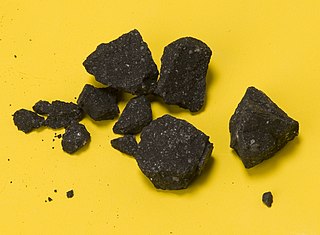
The Sutter's Mill meteorite is a carbonaceous chondrite which entered the Earth's atmosphere and broke up at about 07:51 Pacific Time on April 22, 2012, with fragments landing in the United States. The name comes from Sutter's Mill, a California Gold Rush site, near which some pieces were recovered. Meteor astronomer Peter Jenniskens assigned Sutter's Mill (SM) numbers to each meteorite, with the documented find location preserving information about where a given meteorite was located in the impacting meteoroid. As of May 2014, 79 fragments had been publicly documented with a find location. The largest (SM53) weighs 205 grams (7.2 oz), and the second largest (SM50) weighs 42 grams (1.5 oz).
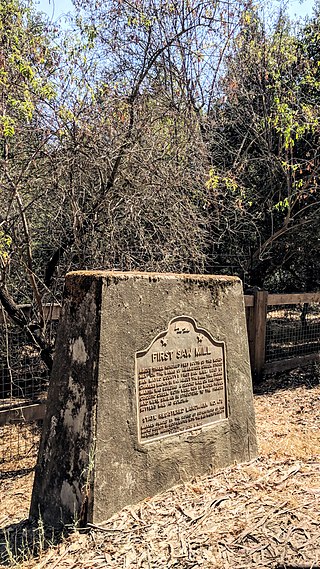
Charles Brown's saw mill was the first saw mill in Woodside, California in San Mateo County, California. MCharles Brown's saw mill site is a California Historical Landmark No. 478 listed on November 9, 1950. San Mateo County's First Sawmill was built on the banks of Alambique Creek in 1847. San Mateo County's First Sawmill powered by the creek was built by Charles Brown. Also in 1847, a second mill was built on San Francisquito Creek by Dennis Martin. The sawmill design was similar to the famous sawmill at Sutter's Mill at Coloma. Sutter's Mill became famous when James W. Marshall found gold in 1848 at the mill. The find stated the California Gold Rush. Brown's adobe house, built in 1839, still stands today.
Nancy Gooch was an early African-American settler in California and one of the state's most successful 19th-century black female landowners. Gooch gained her freedom when California entered the Union as a free state in 1850.
Marshall's Blacksmith Shop is a California Historical Landmark No. 319, now on the private property in Kelsey, California. The Blacksmith Shop was built in 1872 off of what is now California State Route 193 in El Dorado County, California at Gray Eagle Mine. James W. Marshall was a Blacksmith, a carpenter and sawmill operator. The Gray Eagle mine and ore mill is a lode gold mine on 13.2 acres of land in the Mother Lode Country, just south of Kelsey. Marshall was part owner of the Gray Eagle mine.


